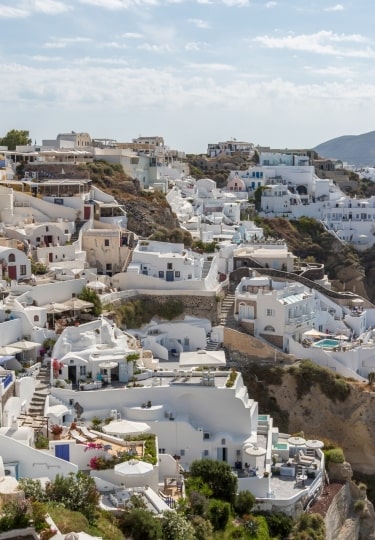What is Santorini known for? Whitewashed cliff-top villages, blue-domed churches, volcanic beaches, and views so surreal they have to be seen to be believed. Without doubt, this is the poster child of the Greek islands, born of fire and shaped by one of the most powerful eruptions in history.
Those wow factors that draw visitors to the island are must-sees, of course. But beneath the glossy surface, local traditions and ancient history run deep. Superb wines are produced using techniques honed over millennia. In smaller villages locals still gather at the kafeneio, the traditional coffee house, to gossip and play backgammon, and ruins quietly tell the island’s often tragic story.
Whether you come for the goldsmiths of capital Fira or the not-so-golden sand beaches, one thing’s for sure: a visit to Santorini won’t leave you untouched. Here are some of the things Santorini is famous for.
The Caldera

Caldera
Santorini’s caldera was created almost 4,000 years ago when a colossal eruption blew out the center of the island, carving the Santorini we know today that graces so many magazine covers.
The eruption is linked by some historians to the legend of Atlantis, and it’s only when sailing into and around it you can see just how vast it is. On one side is Santorini itself with its iconic white cubed houses. On the other lies its sister island, Thirassia, ripped from its sibling by the violent explosion.
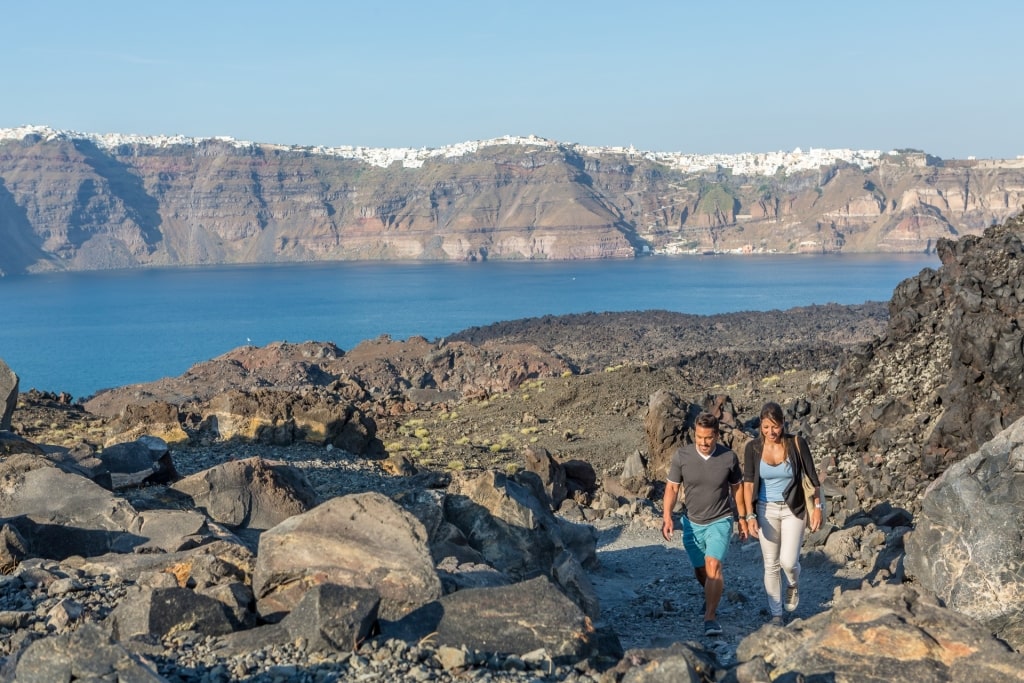
Nea Kameni
In the middle of the bay between them lie two volcanic islands: Palea Kameni, or “old burnt one” and Nea Kameni, “new burnt one”. You can hike right up to the crater itself on the latter, while most boat tours of the bay make a smoldering swim stop between the two in waters warmed by the still-hot lava below.
Fira
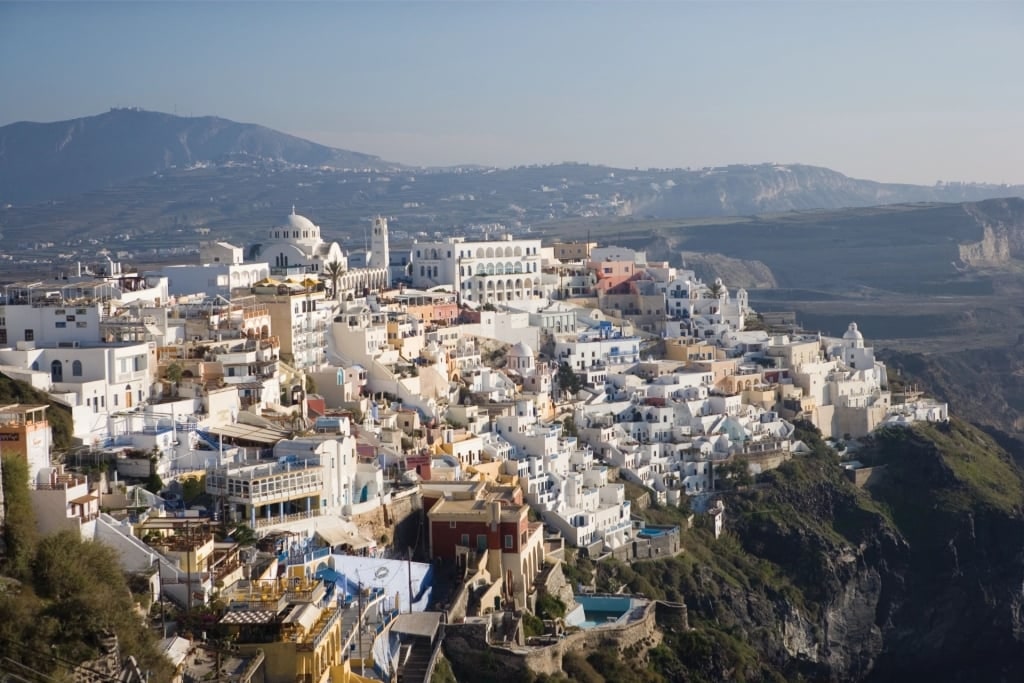
Fira
Those magazine shots where an infinity pool seemingly disappears off the edge of a cliff into the waters of the caldera as Palea and Nea Kameni gently smoke away? They were likely taken in one of the posh hotels that line the edge of Fira.
Santorini’s capital clings to the western edge of the caldera rim, its whitewashed houses lining the cliffs like powdered sugar—another sight that Santorini is famous for.
Destroyed by an earthquake in 1956, much of it has been rebuilt since, but a number of old cave houses survived and remain intact. Carved into the island’s cliffs and once the domain of those less fortunate, many of them have been converted into high-end hotels, bars, and restaurants.

Fira
Fira can be exceptionally busy in summer, but its winding streets, lined with goldsmiths and boutiques, are a delight to explore. While here, you might spot the traditional donkey taxis that once shuttled locals and visitors on the steep cliff paths to the old port by the water. With growing concern over animal welfare though, many visitors now opt for the cable car instead.
Oia
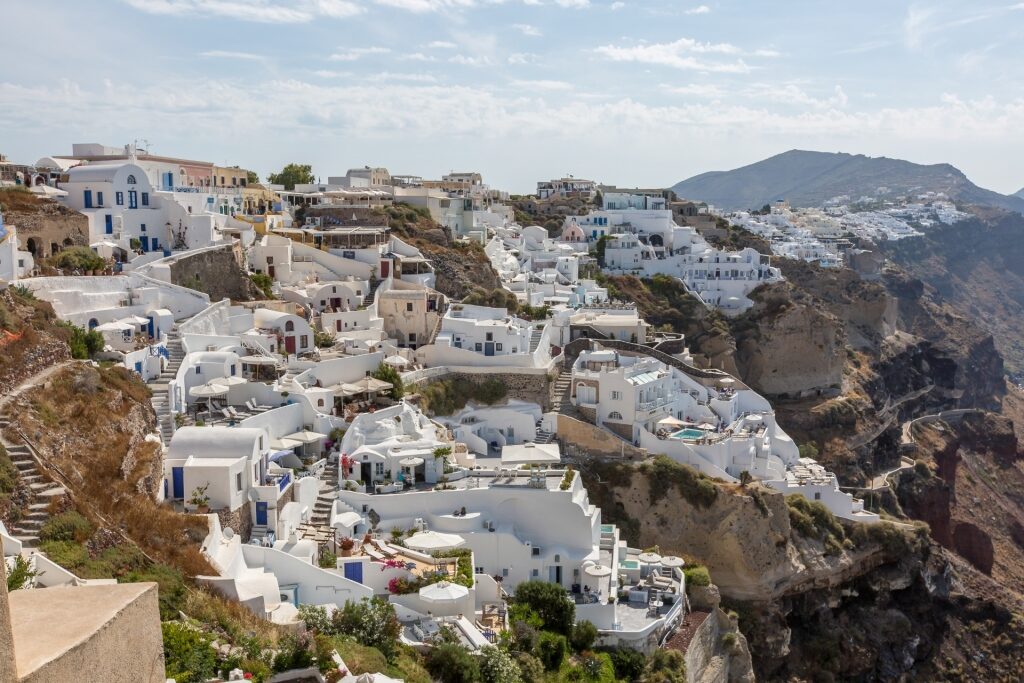
Oia
Ask anyone what Santorini is known for and “sunsets in Oia” is more than likely to be one of the top answers. Perched on the very northern tip of the island, this iconic village clings to the edge of the caldera like a living postcard and offers commanding views out to sea.
Those uninterrupted views are what tempt many to make the 25-minute drive from Fira every evening to see the blazing sun seemingly sink into the Aegean. The views are just as lush during the daytime though. The light is often better for images and there are fewer crowds with which to contend for a vantage spot.
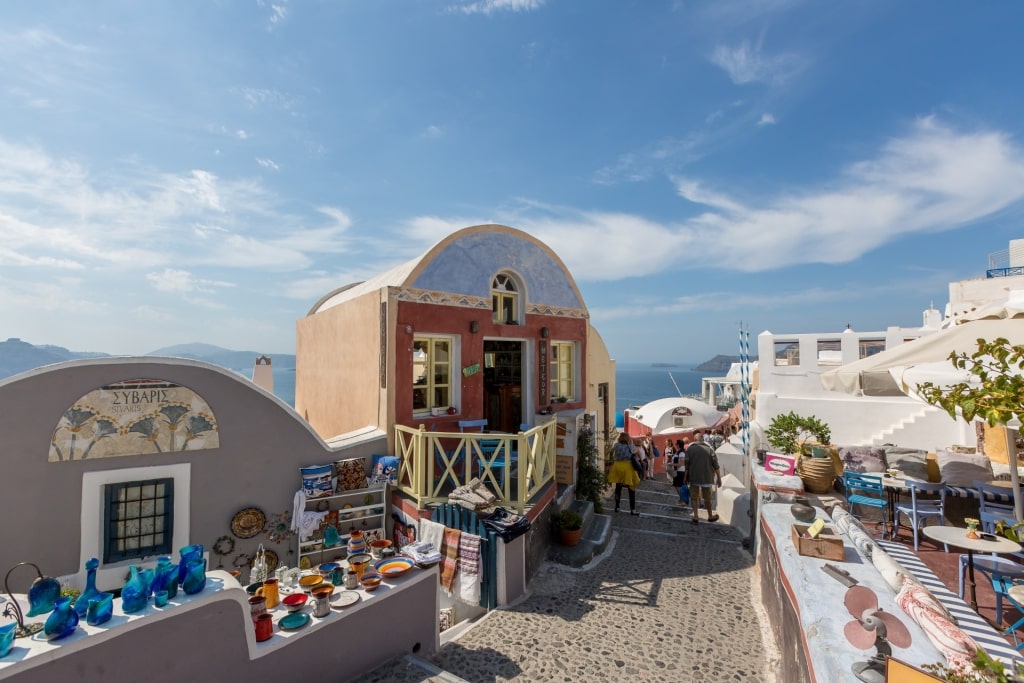
Oia
Take time to wander the streets, packed with art galleries, designer boutiques, and polished cave-house hotels, and to visit the ruined Venetian castle. For those feeling energetic, there are some 200 steps down the cliffs to Ammoudi Bay below. This popular spot is great for seafood lunches, or jumping off the cliffs straight into the deep Aegean below.
Read: Oia Vs. Fira: Which Should You Visit?
Imerovigli & the Cliff-Top Walk
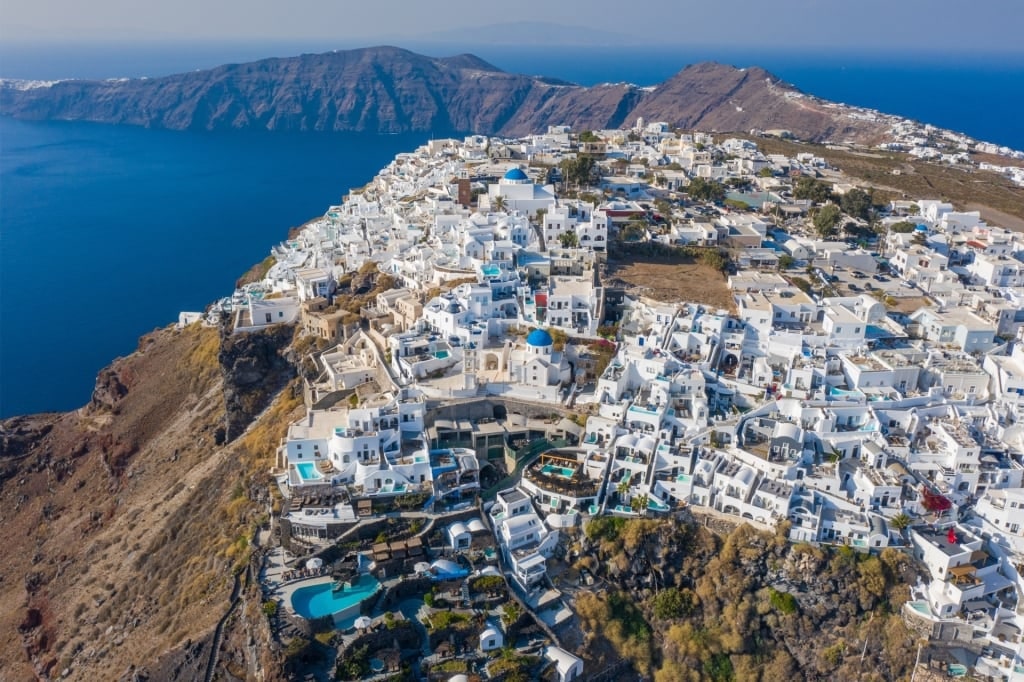
Imerovigli
Fira and Oia are not the only Greek villages on the Caldera’s edge that will take your breath away. Imerovigli is an upscale hamlet between the two, known for more dramatic views and its upscale yet more relaxed vibe.
Unlike its more famed neighbors, it retains the classic Santorini look the island is famed for, but without the crowds. It’s also the best place to see Skaros Rock, a huge promontory that juts into the caldera and is topped with another ruined Venetian-era castle.
Handily, Imerovgli sits in the middle of a challenging but doable six-mile hike between Oia and Fira. On the way you get a new view at every turn as lava fields and white chapels appear seemingly from nowhere. You don’t have to walk the whole thing either. The best stretch from Fira to Imerovigli, around two miles, is both manageable and spectacular.
Black Sand Beaches
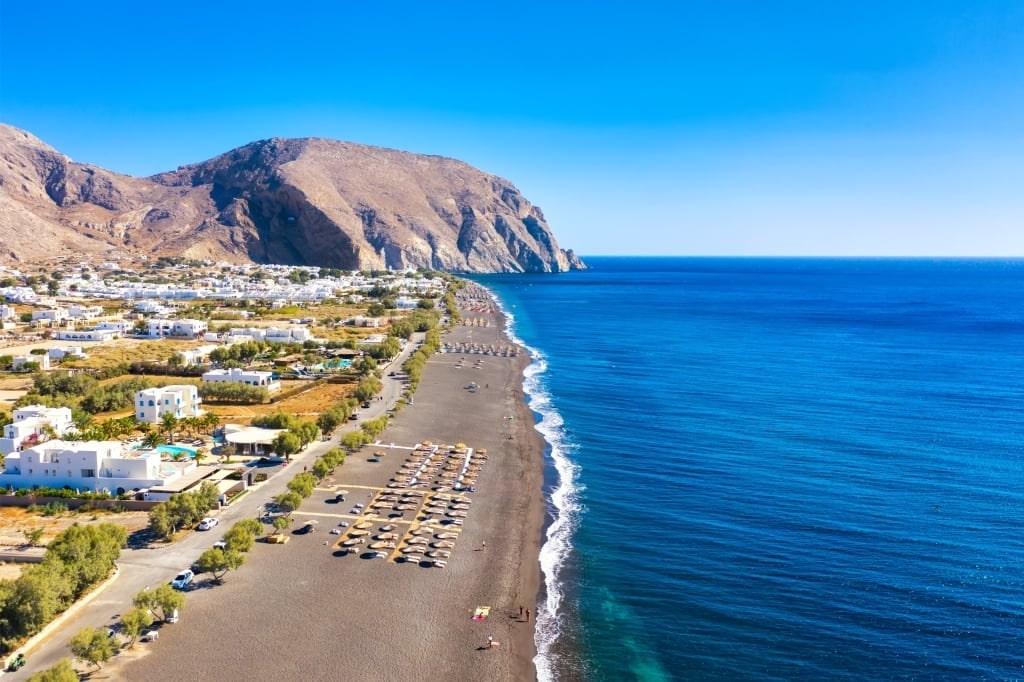
Perissa Beach
While the caldera is the most striking volcanic feature of the west coast of the island, the south and east coasts also offer stark reminders of Santorini’s fiery past. Forget your typically golden sand beaches, though; in resorts such as Perissa, Perivolos, and Kamari, the sand is made up of tiny fragments of dark grey lava.
When wet, these turn strikingly black, giving Santorini’s beaches an otherworldly feel. The west coast might be more high-end and more high-energy, but the resorts here are more for relaxing with sunbeds, water sports, and beach bars aplenty. Take note if visiting: the sand gets incredibly hot when the sun is at its highest making some kind of sandal or beach shoe a must, even when only walking for a few yards.
Akrotiri
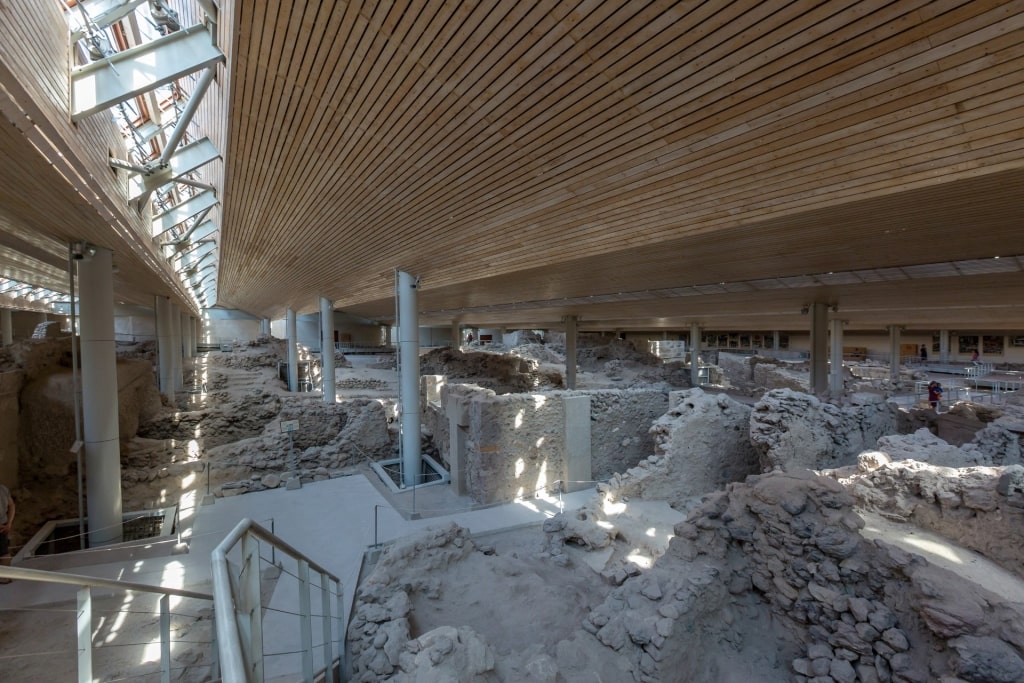
Akrotiri
If you want to see some of the most damaging repercussions of the 1600BC eruption, head to Akrotiri. Set on the southwestern tip of the island some 20 minutes from the capital, the “Greek Pompeii” is an archaeological wonder, and one of the most significant historic sites in the Aegean.
Looking over a dig that is still active from beneath a covered walkway, visitors get to see the remains of an advanced Bronze Age civilization, complete with multi-story buildings, drainage systems, pottery, and even indoor toilets.
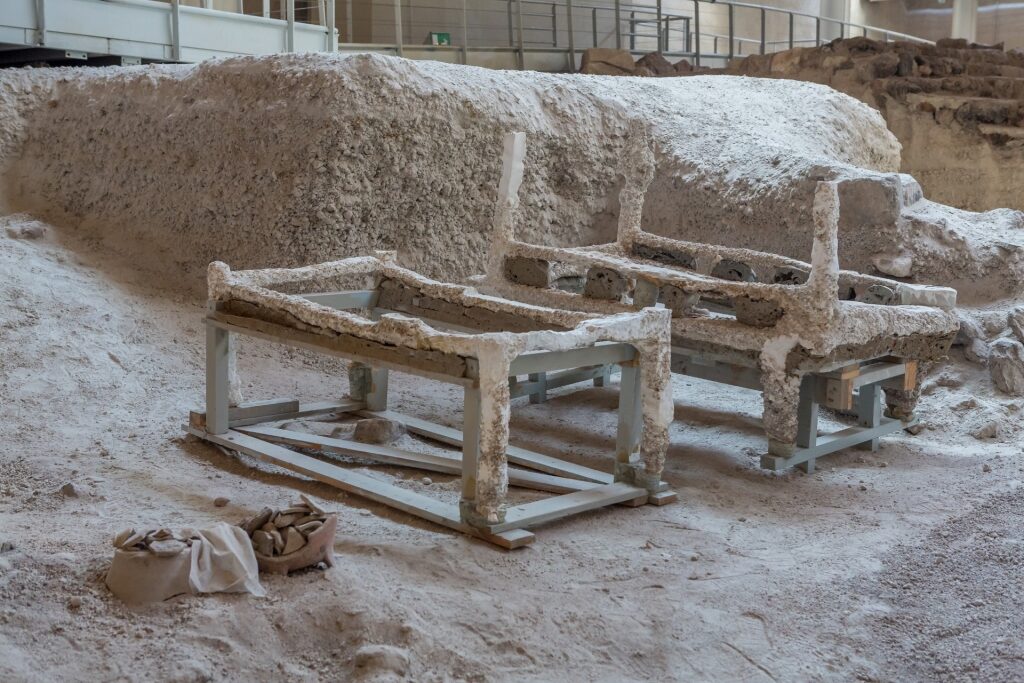
Akrotiri
Unlike Pompeii, it seems the residents were aware of the impending destruction as no human remains have been found; it’s assumed that they left before the volcano blew. But the ash cloud from the eruption preserved the layout of Akrotiri so efficiently that you can still see streets, staircases, and even storage jars in place.
It’s a somber reminder of the power of nature at its full force and a place to both marvel and reflect. The nearby modern village of the same name has a number of good tavernas for a post-visit lunch.
Santorini Wines

Santorini wine
What is Santorini famous for? Increasingly, its wines. Wine-making on Santorini is as ancient as the island itself, at least 3,600 years old, making it one of the oldest wine regions in the world.
It’s also one of the best wine regions in Greece, thanks to the mineral-rich volcanic terroir and the island’s signature assyrtiko grape. These combine to produce some remarkably good crisp whites that also have a slight saline edge thanks to the prevailing sea breezes.
Unlike elsewhere in the world, the vines here don’t grow in rows. Instead they are trained to grow in “kouloura”, a coiled, basket shape that enables the vines to protect the fruit from harsh winds in winter and being exposed to too much sun in summer.
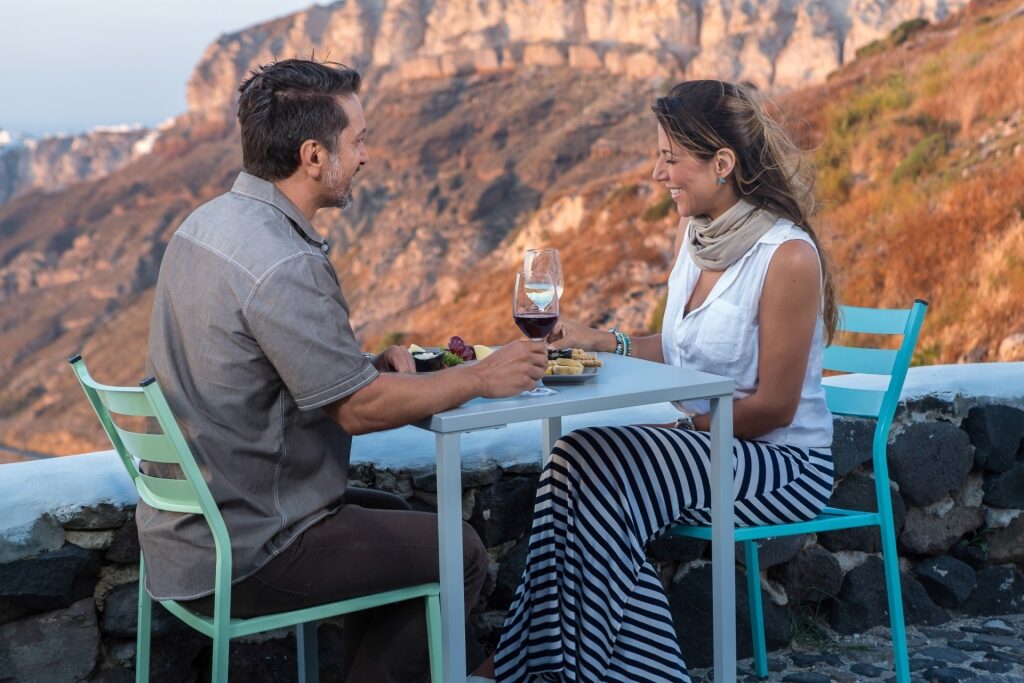
Venetsanos Winery
Santo Wines, perched on the edge of the caldera, is a popular spot for tastings thanks to jaw-dropping views and well-structured tours. Over at Megalochori, Venetsanos Winery, built vertically into the cliff, is another favorite.
For a good overview, try the slightly kitsch Koutsoyannopoulos Wine Museum. Set in a cave near Vothonas, it walks you through the island’s wine history and offers tastings from several different producers.
Churches
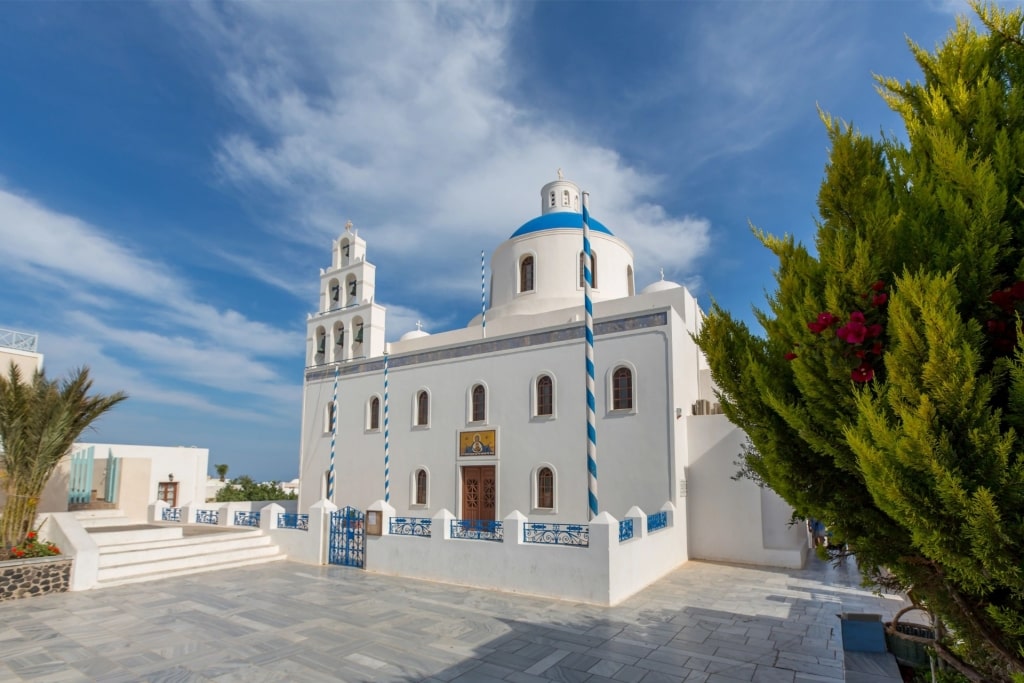
Panagia Platsani, Oia
As well as volcanoes and sunsets, Santorini is well known for its iconic, blue-domed churches. According to local legend, there’s a church for every family on the island—some 600 buildings in total—and you’ll find them everywhere from cliffside villages to tiny hamlets.
The churches that grace most postcards and social media feeds tend to be in Oia and Firostefani, another small village on the Fira to Oia walking trail. Their white walls and bright blue domes provide a stark contrast to the deep blue Aegean in the background.

The Cathedral of St. John the Baptist, Fira
The Venetian era means that not all churches here are Greek Orthodox, either. Prominent Catholic offerings include The Cathedral of St. John the Baptist in Fira. You can often tell the Orthodox and Catholic churches apart thanks to the more muted pastel tones of the latter.
They’re often closed outside of mass, but if you do find one open, feel free to enter and perhaps light a candle. However, follow the local tradition of not wearing exposed knees or shoulders to show appropriate respect.
Pyrgos
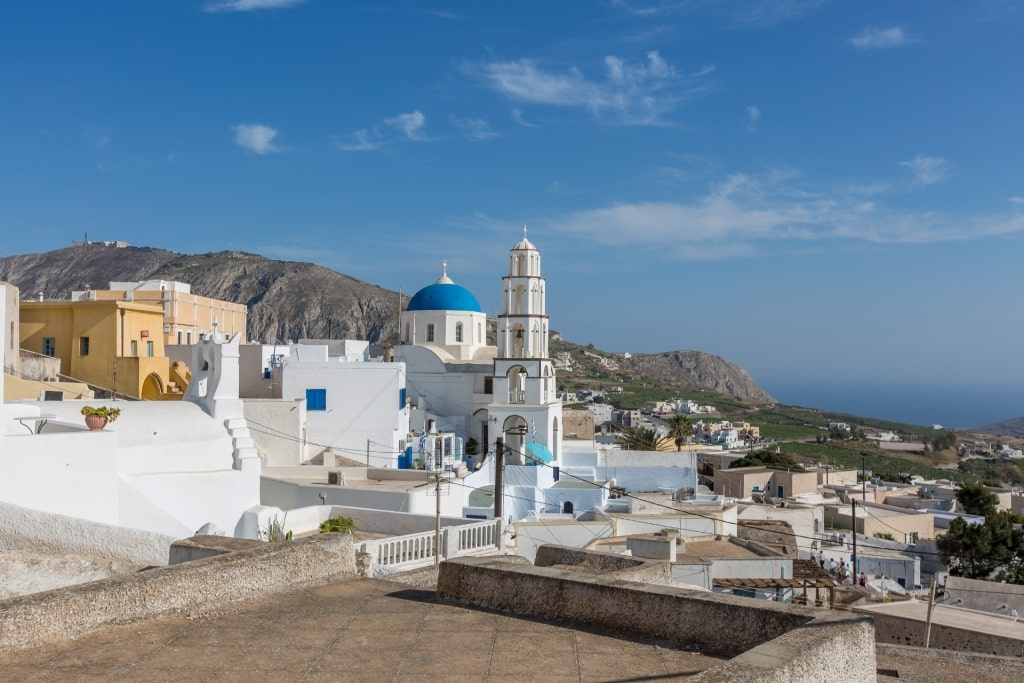
Pyrgos
The caldera-edge villages may get all the attention but ask a local what Santorini is known for and Pyrgos will be high on their list.
Set in the foothills of Mount Profitis almost in the geographical center of the island, Pyrgos is a traditional village and former island capital. Heavily influenced by the Venetians who used it as a living fort—the name means “tower”—its winding streets and alleys are lined with whitewashed houses in a range of styles that reflect the island’s history. Medieval, neoclassical, and Cycladic styles all sit side-by-side.
It’s a great place to wander, sit in a café for thick Greek coffee, or visit one of the many churches. At the top of the hill lies the Venetian Kasteli, or castle. Built in the 15th century to defend the island from pirates, the ruins are modest but the views, across farmland to the east and the caldera to the west, are magnificent.
Ancient Thera
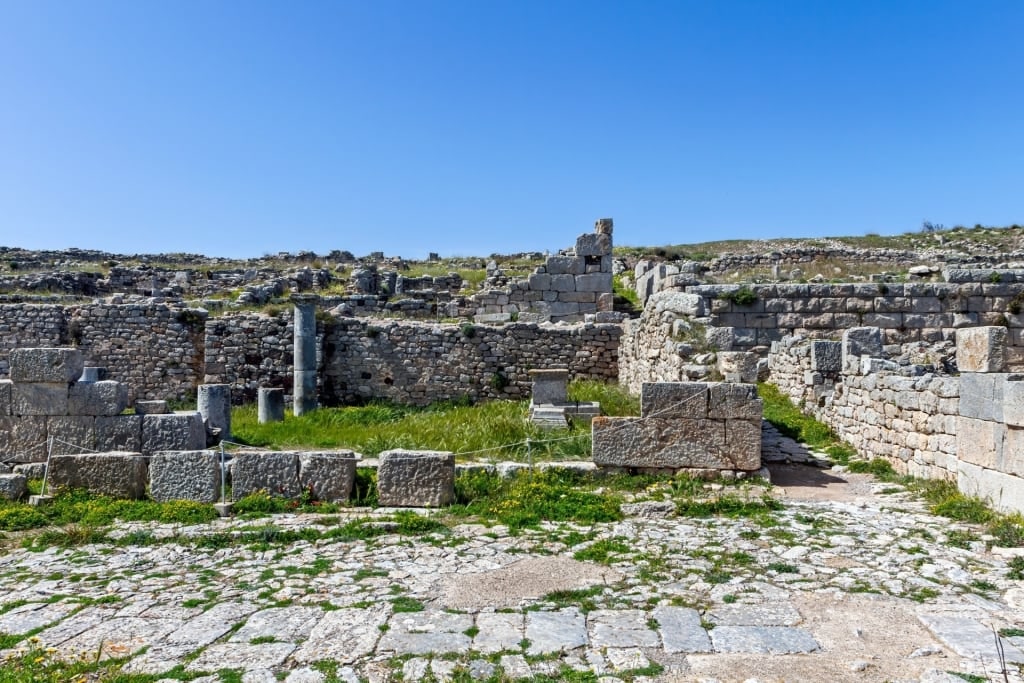
Thera
Santorini takes its more traditional Greek name of Thera from Theras, a Spartan who led the island’s early colonization. This now ruined, ancient city was built in the ninth century BC in his honor.
Set high on Mesa Vouno, the mountain that rises between Perissa and Kamari on the south coast, it offers another fascinating insight into the island’s history. While not as polished as the Greek ruins at Akrotiri, the city includes remnants from the Hellenistic, Roman, and Byzantine periods, again showcasing the island’s history in a number of layers.
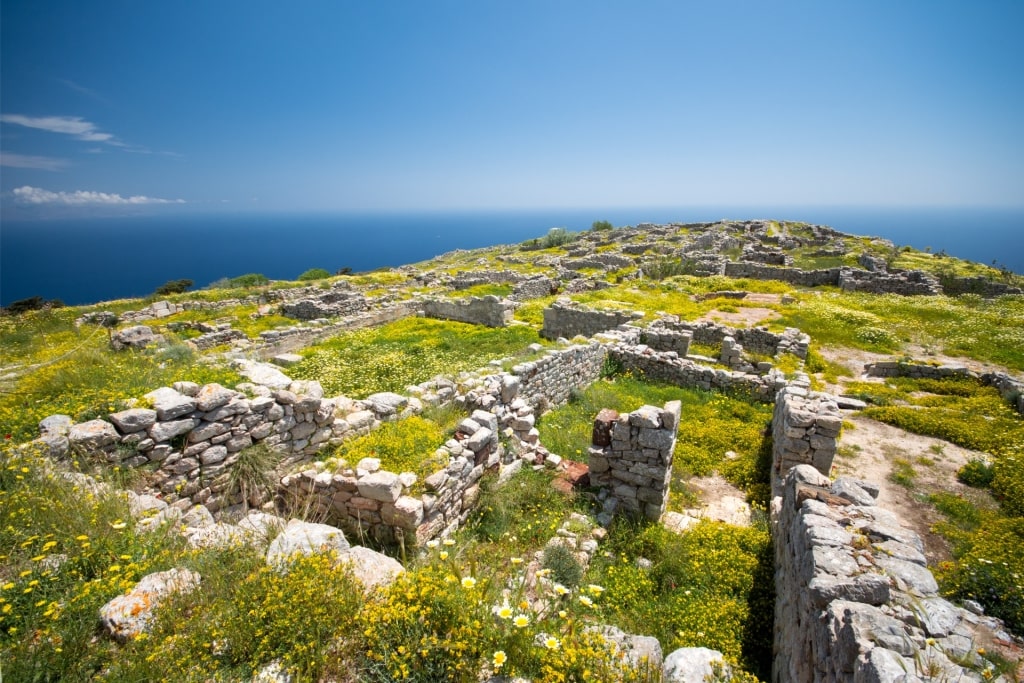
Thera
Wander through temples, streets, courtyards, public buildings, and theaters to get a feel for what life was like then. There are more sweeping sea views from here, too, so pack a camera alongside sunscreen, a hat, water, and sturdy shoes.
If you want to give the latter a decent workout, eschew driving here and take the hike from Perissa instead. It’s about a two-and-a-half-hour climb and a great natural workout.
Red Beach
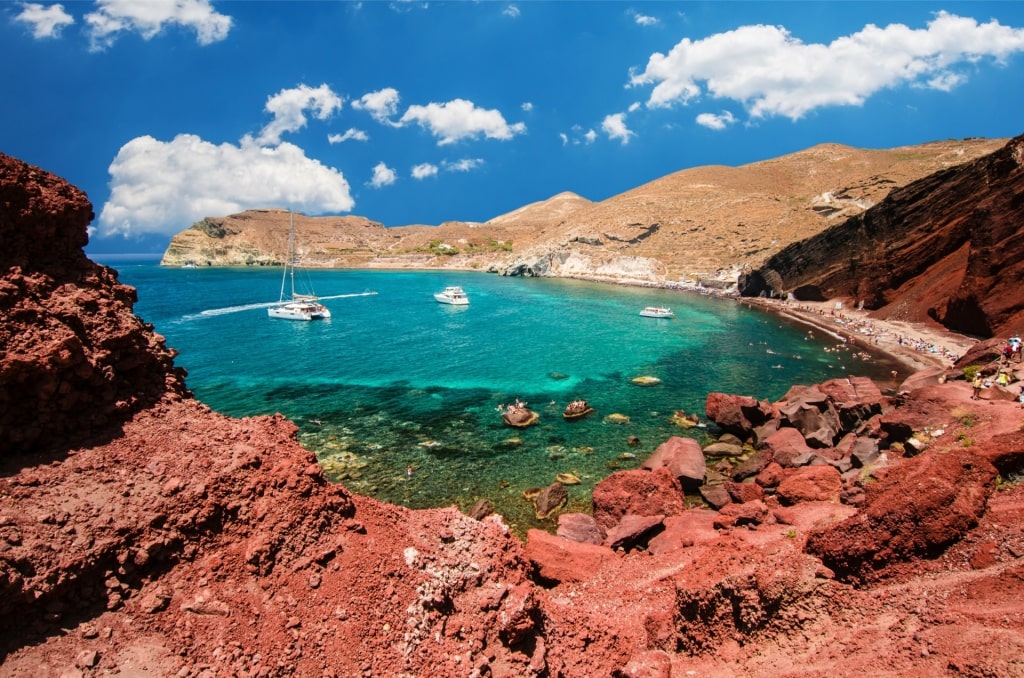
Red Beach
Santorini really is a photographer’s dream, and there are more striking images to be had at the Red Beach, just outside Akrotiri. Unlike the black sand beaches of the east coast or the cliff-jumping spots near Oia, the beach here is made up of fine sand with a deep red tinge.
That red is further enhanced by the surrounding rust-colored cliffs, a legacy of the island’s iron-rich volcanic layers. This Greek beach is fairly small and can fill up pretty quickly in high season, so it pays to visit early or late in the day when there are fewer crowds.
While there are some scattered lounges and umbrellas to rent, there are no other facilities, so make sure to pack food and drink before visiting. Be aware, too, that it’s quite a scramble to get down from the road to the beach along a rocky path.
Thirassia
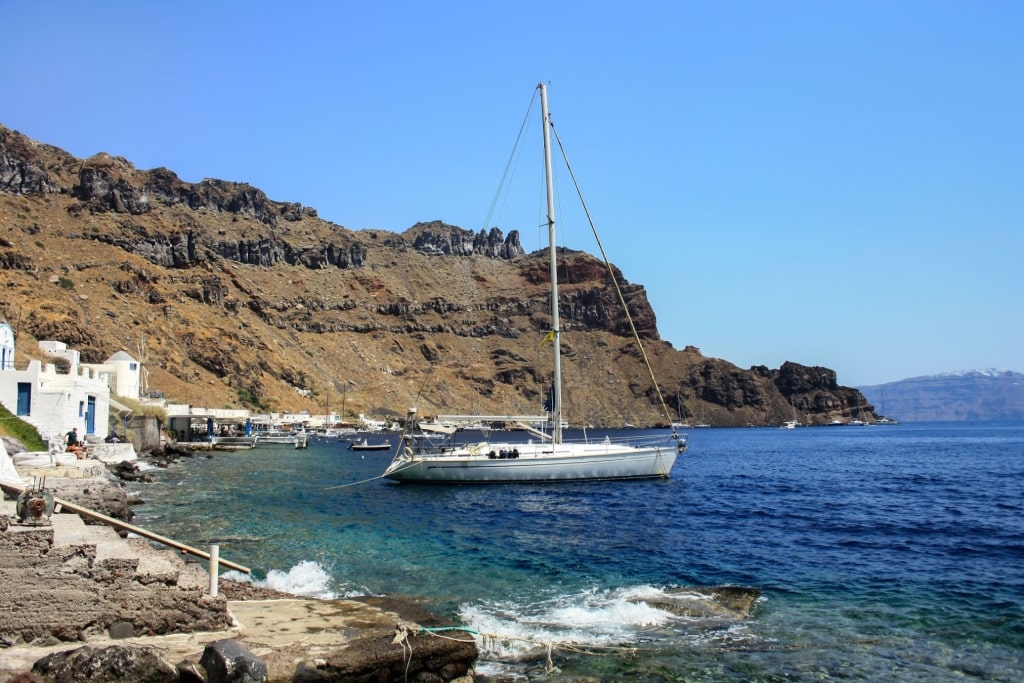
Thirassia
For those looking for a glimpse into what Santorini was known for before the boutique hotels and tourist crowds arrived, Thirassia is the place to go. The small island sits across from Santorini on what would have been the opposite edge of the volcano rim before the island’s implosion.
While boats only take around 30 minutes to make the crossing from Oia or Fira, it really does feel like a different world. The same dramatic landscapes remain, but with few villages, a couple of small farms, and just a handful of tavernas, the island is much more peaceful.
Manolas is the main village. Sitting at the top of a climb from the port, it’s low key and authentic; a great spot for lunch or a quiet wander. Make sure to look back across the bay to the main island for yet more amazing photos.
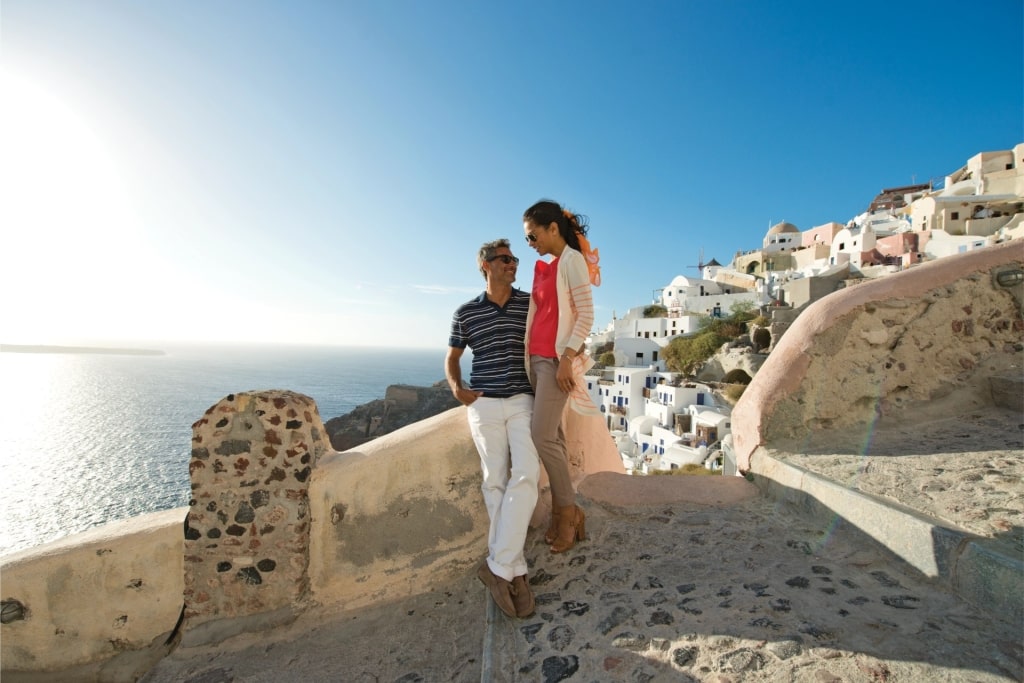
Santorini
Ready to discover this magical island for yourself? Browse Celebrity’s cruises to Santorini and plan your dream vacation.
